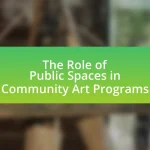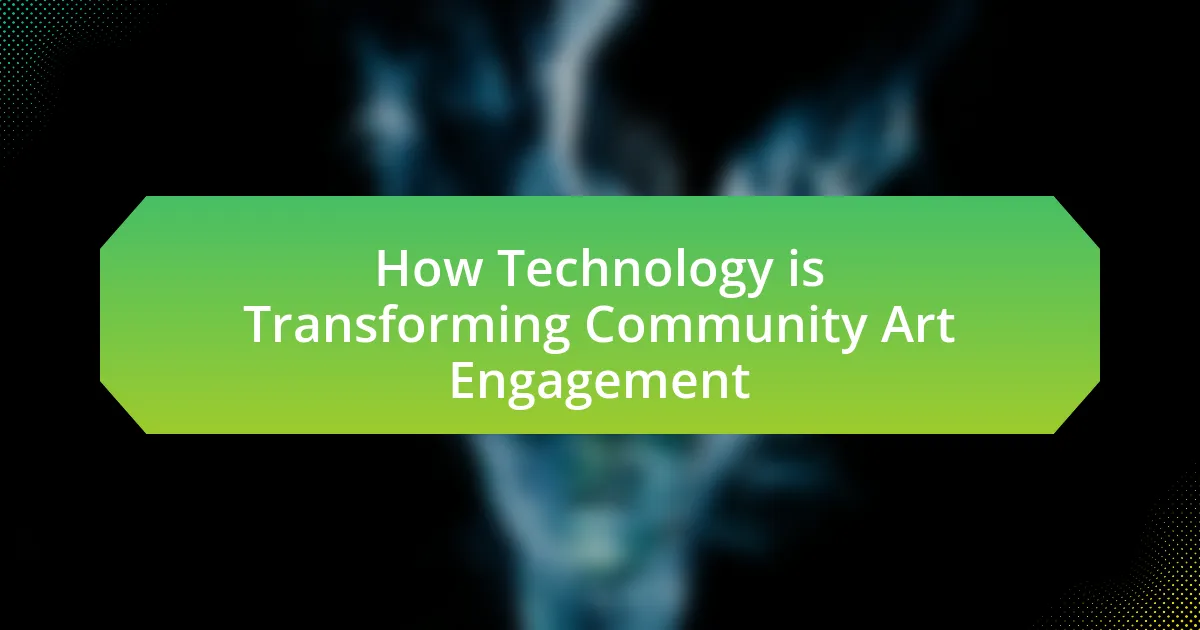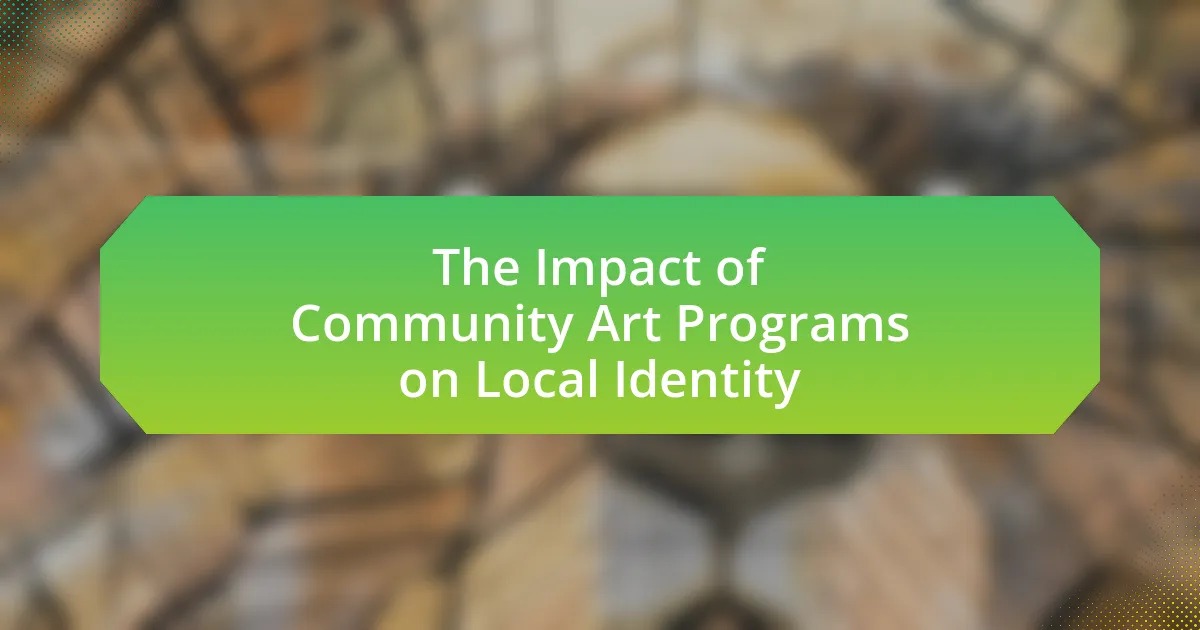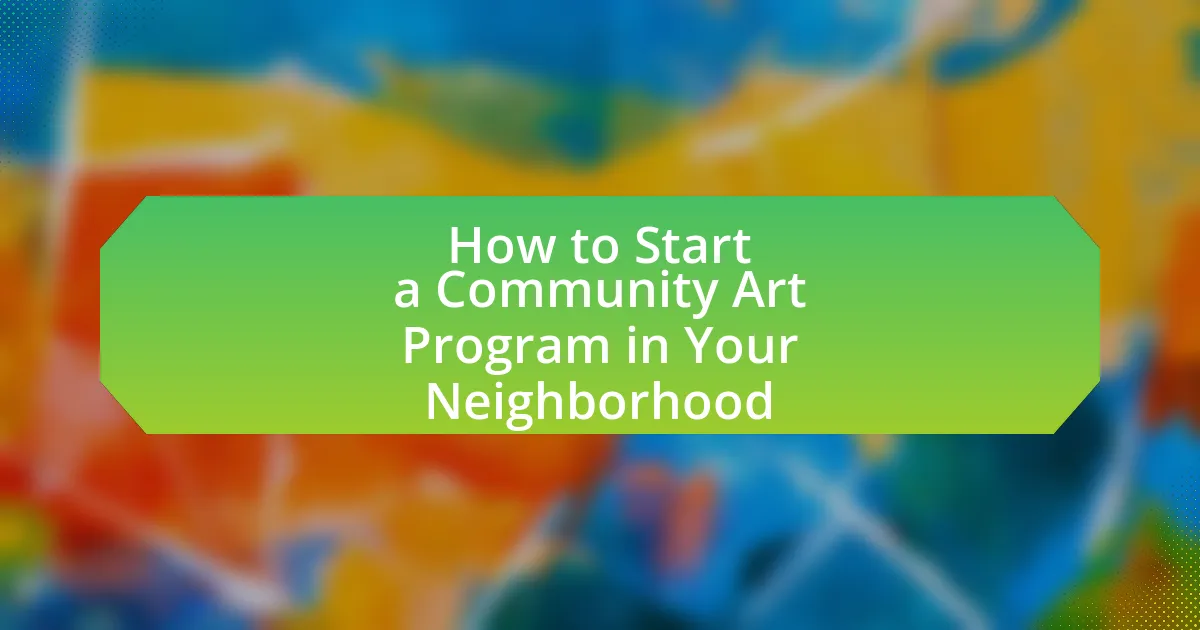Art serves as a powerful tool for social change, utilizing creative expression to address societal issues, inspire action, and foster community engagement. Historical movements, such as the Harlem Renaissance and the Mexican Mural Movement, exemplify how artists have challenged injustices and promoted cultural pride through their work. Community programs, like the Mural Arts Program in Philadelphia and Theaster Gates’ Rebuild Foundation, demonstrate the effectiveness of art in transforming neighborhoods and enhancing civic participation. By engaging local artists and community members, these initiatives not only raise awareness about social issues but also create a sense of ownership and empowerment, ultimately driving social change and improving community well-being.
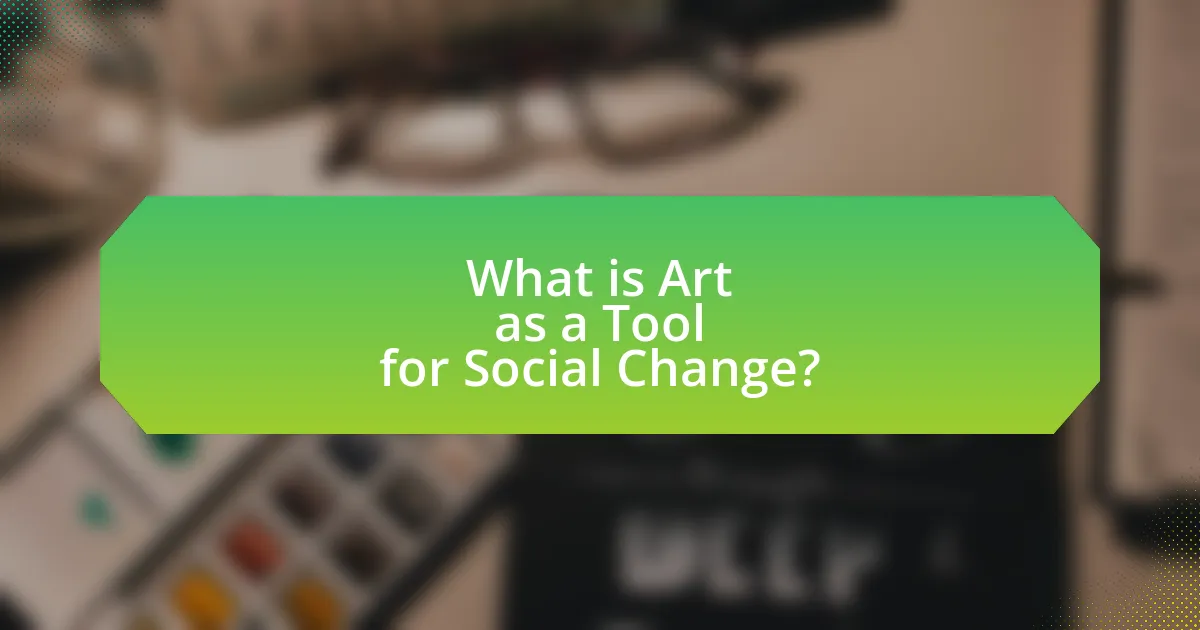
What is Art as a Tool for Social Change?
Art as a tool for social change is the use of creative expression to address social issues, inspire action, and foster community engagement. This approach has been historically significant, as seen in movements like the Harlem Renaissance, where artists used their work to challenge racial injustices and promote cultural pride. Additionally, programs such as “The Mural Project” in various cities demonstrate how public art can transform neighborhoods, raise awareness about social issues, and encourage dialogue among community members. These examples illustrate that art not only reflects societal conditions but also actively participates in shaping and improving them.
How does art influence social movements?
Art influences social movements by serving as a powerful medium for expression and communication, enabling marginalized voices to be heard and fostering community engagement. Through visual art, music, theater, and literature, artists can convey messages that resonate with social issues, mobilizing individuals and communities to take action. For instance, the use of graffiti during the Arab Spring effectively communicated dissent and inspired collective action, demonstrating how art can galvanize public sentiment and drive social change. Additionally, studies have shown that art initiatives, such as community murals or performance art, can enhance civic participation and create a sense of belonging, further solidifying their role in social movements.
What historical examples illustrate art’s impact on social change?
Art has historically played a significant role in driving social change, as evidenced by movements such as the Harlem Renaissance, which celebrated African American culture and challenged racial stereotypes in the early 20th century. This cultural movement produced influential artists like Langston Hughes and Zora Neale Hurston, whose works highlighted social injustices and inspired activism for civil rights. Another example is the Mexican Mural Movement, where artists like Diego Rivera used public murals to address social issues, promote labor rights, and critique capitalism during the early 20th century. These murals not only beautified public spaces but also educated the masses about social inequalities, fostering a sense of community and collective action. Additionally, the anti-war protests of the 1960s utilized music and visual art, such as the iconic poster art of the era, to galvanize public sentiment against the Vietnam War, demonstrating how art can mobilize communities for political change.
How do different art forms contribute to social awareness?
Different art forms contribute to social awareness by serving as powerful mediums for expression and communication of social issues. Visual arts, such as paintings and murals, can depict societal struggles and provoke thought, as seen in the works of artists like Banksy, who addresses themes like poverty and war. Theater and performance art engage audiences emotionally, often highlighting injustices and prompting discussions, exemplified by plays like “The Vagina Monologues,” which raise awareness about women’s rights and violence. Music, particularly genres like hip-hop and folk, often conveys messages about social justice, with artists like Kendrick Lamar addressing systemic racism and inequality in their lyrics. These art forms not only reflect societal issues but also inspire action and foster community dialogue, making them essential tools for promoting social awareness.
Why is community engagement important in art for social change?
Community engagement is crucial in art for social change because it fosters collaboration and amplifies diverse voices within the community. Engaging community members in the artistic process ensures that the art reflects their experiences, challenges, and aspirations, leading to more impactful and relevant social commentary. For instance, projects like the “Chicago Public Art Program” have demonstrated that when local artists collaborate with residents, the resulting artworks not only beautify neighborhoods but also address social issues such as violence and inequality, thereby promoting dialogue and community cohesion. This participatory approach enhances the effectiveness of art as a catalyst for social change by creating a sense of ownership and empowerment among community members.
What role do local artists play in community programs?
Local artists play a crucial role in community programs by fostering cultural expression and enhancing community engagement. They contribute their creative skills to develop programs that reflect the community’s identity, promote social cohesion, and address local issues. For instance, studies have shown that community art projects led by local artists can increase participation in civic activities and improve community well-being. According to a report by the National Endowment for the Arts, arts engagement can lead to stronger community ties and increased civic involvement, demonstrating the significant impact local artists have in shaping vibrant, inclusive communities.
How can community involvement enhance the effectiveness of art initiatives?
Community involvement enhances the effectiveness of art initiatives by fostering a sense of ownership and relevance among participants. When community members actively engage in the planning and execution of art projects, they contribute their unique perspectives and cultural narratives, which can lead to more meaningful and impactful art. For instance, a study by the National Endowment for the Arts found that community-driven art projects often result in higher attendance and participation rates, as locals feel a personal connection to the work being created. This connection not only increases the visibility of the art initiative but also strengthens community bonds and encourages ongoing collaboration, ultimately leading to sustained engagement and support for future projects.
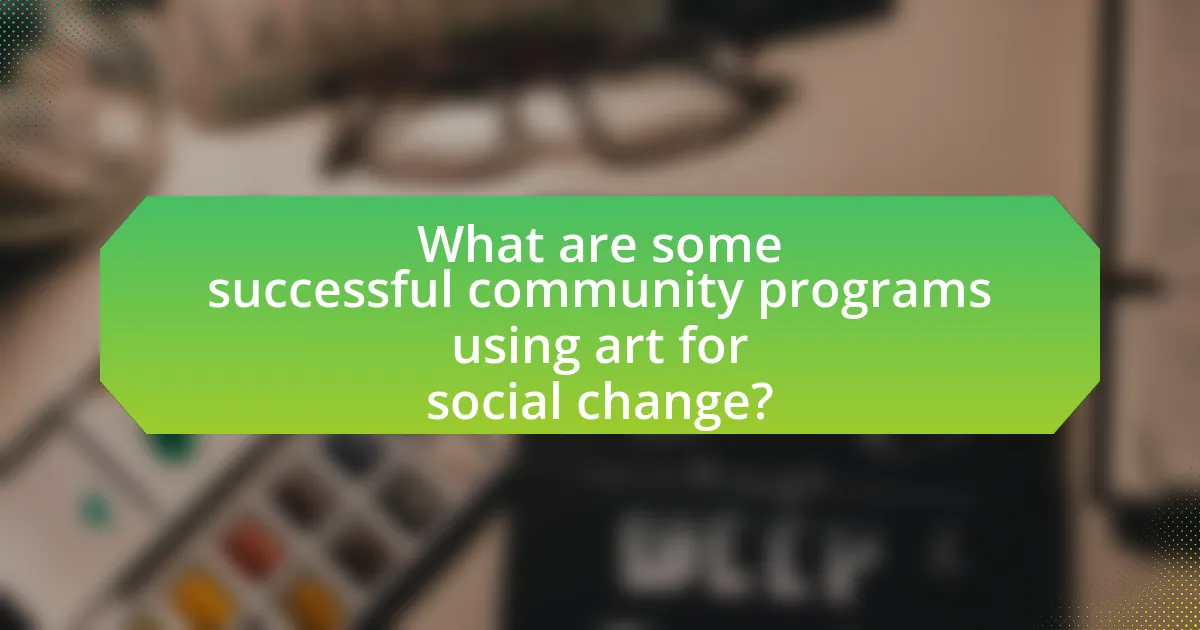
What are some successful community programs using art for social change?
Successful community programs using art for social change include the “Mural Arts Program” in Philadelphia, which engages local artists and community members to create murals that reflect social issues and promote dialogue. This program has resulted in over 4,000 murals, contributing to community revitalization and reducing crime rates in targeted neighborhoods. Another example is “Theaster Gates’ Rebuild Foundation,” which transforms vacant buildings into cultural spaces, fostering community engagement through art and performance. This initiative has revitalized neighborhoods on the South Side of Chicago, creating jobs and enhancing local culture. Additionally, “Art for Justice Fund” supports artists and organizations working to reform the criminal justice system through creative expression, raising awareness and funding for social justice initiatives. These programs demonstrate the powerful impact of art in driving social change and community development.
How do these programs operate?
Community programs that utilize art as a tool for social change operate by engaging participants in creative activities that foster collaboration, expression, and awareness of social issues. These programs typically involve workshops, public art projects, and performances that encourage community members to explore their identities and address local challenges. For instance, programs like “Art for Change” have been shown to improve community cohesion and empower marginalized voices by providing a platform for storytelling through various art forms. Research indicates that such initiatives can lead to increased civic engagement and a stronger sense of belonging among participants, demonstrating their effectiveness in driving social transformation.
What types of art are commonly used in these programs?
Community programs that utilize art as a tool for social change commonly employ visual arts, performing arts, and literary arts. Visual arts include painting, sculpture, and mural creation, which serve to beautify public spaces and convey social messages. Performing arts encompass theater, dance, and music, often used in community events to engage participants and raise awareness about social issues. Literary arts, such as poetry and storytelling, provide a platform for personal expression and community narratives. These art forms are effective in fostering dialogue, building community identity, and inspiring action towards social change.
How do these programs measure their impact on the community?
These programs measure their impact on the community through quantitative and qualitative assessments, including surveys, interviews, and community feedback. For instance, they often utilize pre- and post-program surveys to gauge changes in participants’ attitudes, skills, and community engagement levels. Additionally, they may track participation rates and demographic data to analyze reach and inclusivity. Research has shown that programs employing these methods can demonstrate significant improvements in community cohesion and individual empowerment, as evidenced by studies highlighting increased social capital and reduced isolation among participants.
What challenges do community art programs face?
Community art programs face several significant challenges, including funding limitations, community engagement, and sustainability. Funding is often inadequate, as many programs rely on grants and donations that can fluctuate, making it difficult to maintain consistent operations. Additionally, engaging the community can be challenging, as programs must effectively reach diverse populations and ensure participation from various demographic groups. Sustainability is another critical issue, as programs need to develop long-term strategies to remain relevant and impactful, often requiring ongoing support and resources. These challenges can hinder the effectiveness of community art initiatives aimed at fostering social change.
How can funding issues affect the sustainability of these programs?
Funding issues can critically undermine the sustainability of community art programs by limiting resources necessary for operation and growth. Insufficient funding can lead to reduced staffing, decreased program offerings, and the inability to maintain facilities or equipment, which directly impacts the quality and reach of the programs. For instance, a study by the National Endowment for the Arts found that organizations with stable funding sources are 50% more likely to sustain their programs over time compared to those reliant on inconsistent funding. This financial instability can result in program closures, diminished community engagement, and a loss of trust among participants, ultimately jeopardizing the long-term impact of art as a tool for social change.
What barriers exist in engaging diverse community members?
Barriers in engaging diverse community members include language differences, cultural misunderstandings, and socioeconomic disparities. Language differences can hinder effective communication, making it difficult for individuals from non-native backgrounds to participate fully in community programs. Cultural misunderstandings may lead to misinterpretations of intentions or values, creating a disconnect between organizers and participants. Socioeconomic disparities can limit access to resources, such as transportation or time, which are essential for participation in community activities. According to a study by the National Endowment for the Arts, these barriers significantly impact the inclusivity and effectiveness of community engagement initiatives.
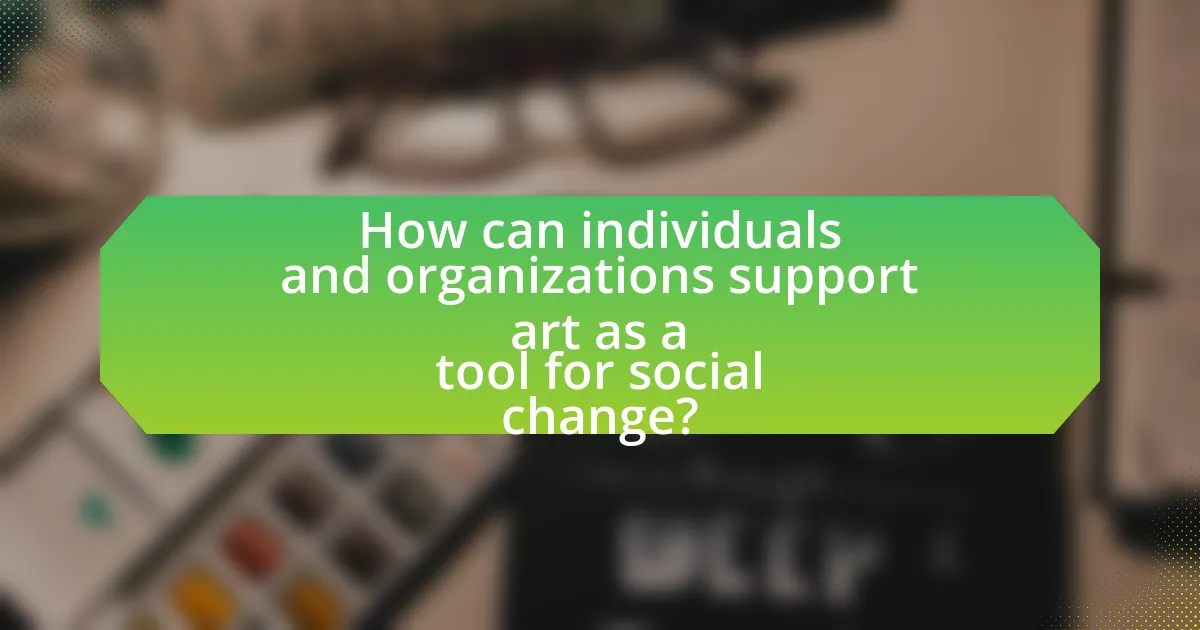
How can individuals and organizations support art as a tool for social change?
Individuals and organizations can support art as a tool for social change by funding and promoting community art programs that address social issues. For instance, organizations like the National Endowment for the Arts provide grants specifically aimed at projects that foster community engagement and social impact through art. Additionally, individuals can volunteer their time or resources to local art initiatives that focus on themes such as social justice, equality, and environmental awareness, thereby amplifying the voices of marginalized communities. Research shows that art initiatives can lead to increased civic engagement and community cohesion, as evidenced by programs like Art for Change, which has successfully transformed neighborhoods through collaborative art projects.
What are effective ways to promote community art initiatives?
Effective ways to promote community art initiatives include leveraging social media platforms, organizing local events, and collaborating with schools and community organizations. Social media platforms like Facebook and Instagram can reach a wide audience, allowing for the sharing of art projects and events, which can increase community engagement. Organizing local events, such as art fairs or workshops, provides opportunities for community members to participate and showcase their talents, fostering a sense of ownership and pride in local art. Collaborating with schools and community organizations can enhance outreach efforts, as these entities often have established networks and resources that can support art initiatives. For instance, a study by the National Endowment for the Arts found that community engagement in the arts can lead to increased social cohesion and improved community well-being, highlighting the importance of these promotional strategies.
How can social media be leveraged to raise awareness?
Social media can be leveraged to raise awareness by facilitating the rapid dissemination of information and engaging communities in dialogue. Platforms like Facebook, Twitter, and Instagram allow organizations to share impactful stories, visuals, and campaigns that resonate with audiences, thereby increasing visibility for social issues. For instance, the Ice Bucket Challenge in 2014 raised over $115 million for ALS research through viral participation and sharing on social media, demonstrating the effectiveness of these platforms in mobilizing support and spreading awareness.
What partnerships can enhance the reach of art programs?
Collaborations with local schools, community organizations, and businesses can significantly enhance the reach of art programs. Schools provide access to a diverse student population, fostering engagement and participation in art initiatives. Community organizations, such as non-profits focused on social issues, can help target specific demographics and expand outreach efforts. Partnerships with local businesses can offer financial support, resources, and venues for exhibitions, further amplifying visibility and participation. For instance, a study by the National Endowment for the Arts found that community-based art programs that partnered with schools and local organizations saw a 40% increase in participant engagement compared to those that operated independently.
What best practices should be followed in community art programs?
Community art programs should prioritize inclusivity, collaboration, and sustainability. Inclusivity ensures diverse community participation, allowing various voices and perspectives to be represented, which enhances the program’s relevance and impact. Collaboration with local artists, organizations, and community members fosters a sense of ownership and shared purpose, leading to more meaningful and effective projects. Sustainability involves creating programs that can continue to thrive over time, whether through securing funding, building partnerships, or developing community leadership. Research indicates that programs following these best practices are more successful in achieving social change and fostering community engagement, as evidenced by the National Endowment for the Arts’ findings on community-driven art initiatives.
How can programs ensure inclusivity and accessibility?
Programs can ensure inclusivity and accessibility by implementing universal design principles that accommodate diverse needs. This involves creating environments and experiences that are usable by all individuals, regardless of their abilities or backgrounds. For instance, incorporating features such as wheelchair ramps, sign language interpreters, and materials in multiple languages can significantly enhance accessibility. Research indicates that inclusive programs not only improve participation rates but also foster a sense of belonging among community members, as evidenced by studies showing that organizations prioritizing accessibility see increased engagement and satisfaction among participants.
What strategies can be implemented for long-term success?
To achieve long-term success in community programs that utilize art as a tool for social change, organizations should implement strategies such as fostering community engagement, ensuring sustainability through funding diversification, and measuring impact through data collection. Community engagement is crucial as it builds trust and encourages participation, leading to programs that are more relevant and effective. For instance, programs that actively involve local artists and residents in the planning and execution phases tend to resonate more deeply with the community, as evidenced by the success of initiatives like the Mural Arts Program in Philadelphia, which has transformed neighborhoods and reduced crime rates.
Sustainability can be achieved by diversifying funding sources, including grants, donations, and partnerships with local businesses, which helps to mitigate financial risks and ensures the longevity of programs. Research from the National Endowment for the Arts indicates that organizations with multiple funding streams are more resilient and capable of adapting to changing circumstances.
Finally, measuring impact through data collection allows organizations to assess the effectiveness of their programs and make informed decisions for future initiatives. Programs that utilize pre- and post-surveys to evaluate community sentiment and engagement levels demonstrate a commitment to accountability and continuous improvement, as shown in studies conducted by the Urban Institute, which highlight the importance of data in driving successful social change initiatives.
How can individuals get involved in supporting art for social change?
Individuals can get involved in supporting art for social change by participating in community art programs, volunteering for organizations that promote social justice through art, and attending or organizing events that showcase socially conscious artwork. Engaging with local artists and supporting their initiatives can amplify the impact of art in addressing social issues. For instance, organizations like Art for Change and Creative Time have successfully mobilized community members to use art as a medium for activism, demonstrating that collective efforts can lead to significant societal transformations.

